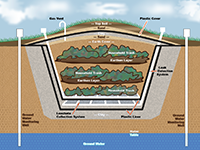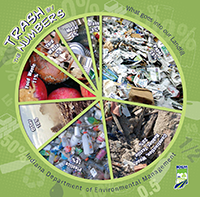Where Trash Goes, Past and Present
For hundreds of years, people used dumps to get rid of their trash. The dump was a pit or field outside of town where people left their trash. Dumps were perfect habitats for pests such as fleas, mosquitoes, and rats. Dumps provided pests with food, water, shelter, and space to live. When it rained, the water would filter through the trash in the dump. The water would become dirty or contaminated, and flow into local streams and groundwater. People drank, bathed, and watered crops and livestock with the contaminated water.
With advancements in science people learned how contaminated water made them sick. To protect human health and the environment, in the United States (U.S.) we still bury trash, but not in open dumps. In the U.S. we bury our trash in landfills. A landfill’s basic function is to isolate buried trash from the surrounding environment. Landfills use a series of layers and barriers to keep trash in its place.
Since 1986, the Indiana Department of Environmental Management (IDEM) has been the state agency to regulate landfills in Indiana. Currently there are 34 municipal solid waste (MSW) landfills operating in Indiana. MSW is commonly referred to as trash or garbage, and includes items such as food, paper, plastics, leather, wood, glass, metals, and other waste.
Landfill Layers and Barriers
- Clay Soil: Used as a bottom and top layer during landfill construction. Forms a barrier between the trash and the environment.
- Liner: A thick plastic layer on the top and bottom of a landfill. It keeps leachate and methane gas within the landfill. Protects groundwater and the environment.
- Leachate: Any liquid oozing through the landfill. It can be liquids present in the trash or from precipitation such as rain, snow, or sleet.
- Trash: Everyday items discarded by households, businesses, and organizations. Trash is also referred to as garbage or solid waste.
- Methane Gas Pipes: Decomposing trash produces methane gas. Pipes throughout the landfill vent the methane to the surface of a landfill.
- Groundwater Monitoring Well: Used to monitor groundwater for contamination.
- Closed Landfill: A landfill no longer accepting trash.
- Topsoil: Soil added on top of the clay cap. It supports the growth of vegetation.
- Landscaping: After a landfill is closed, native grasses will be planted in the top soil. The plants will help keep top soil from eroding.
A Closed Landfill
When a landfill is at capacity, or full, we call it a closed landfill. Closed landfills must monitor the following for at least 30 years:
- Cover
- Leachate collection system
- Gas extraction system (methane gas)
- Sedimentation and erosion control (landscaping)
- Groundwater system (for any contamination)
Trash by the Numbers
If you went to the landfill and sorted the trash into categories, the trash would fall into eight categories:
- Paper
- Construction, Wood, Rubber, Textile
- Plastic
- Food Waste
- Other
- Yard Waste
- Metal
- Glass
- 28% of the landfill is paper products (e.g., newspaper, mail, catalogues, paperboard [cereal box], cardboard).
- 20% of the landfill is construction waste, wood, rubber, textile (e.g., brick, lumber, garden hose, clothing).
- 16% of the landfill is plastics (e.g., water bottle, milk jug, laundry detergent, yogurt container, plastic bag, chip bag).
- 11% of the landfill is food waste (e.g., fruit, vegetables, bread, meat, chips).
- 10% of the landfill is other (i.e., items that didn’t fit into the other categories).
- 6% of the landfill is yard waste
- 6% of the landfill is metal
- 3% of the landfill is glass


